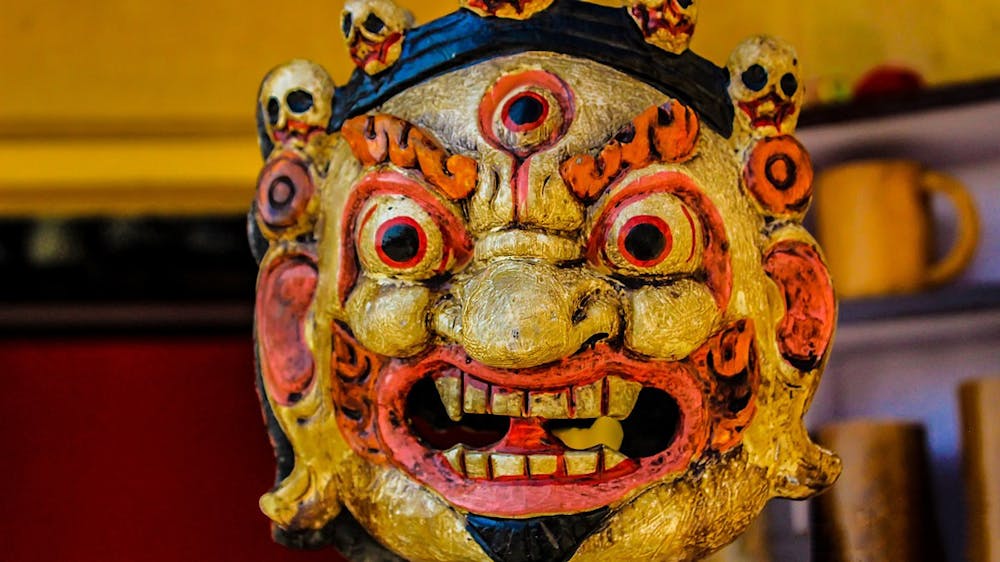In a cinema landscape where almost every horror film is a metaphor, it becomes slightly disappointing when a film doesn’t execute its messages well, or when it fails to land on any message at all. Regardless of its muddy themes, Bishal Dutta’s feature film directorial debut, It Lives Inside, puts a twist on the possession horror film archetype by following an Indian-American teenage girl’s experience with an evil spirit from Hindu mythology.
The protagonist, Samidha (Megan Suri), who refers to herself as Sam throughout the film in an attempt to assimilate into her predominantly white suburban town, is the daughter of traditional and religious Indian parents. The story follows her in the aftermath of a falling out with her childhood best friend, Tamira, while she tries to fully assimilate into American culture, slowly abandoning her own heritage as she does so.
From the beginning, her mother is insistent that she continue to be involved in her family’s traditions and speak their language, but we see Sam respond to her mother’s Hindi in English and abandon her mom’s home-cooked lunch for whatever is being served at her high school’s cafeteria.
As a result of her behavior, Sam has grown distant from Tamira, who becomes an outcast from the rest of the school. Tamira, played by Mohana Krishnan, is not doing well. She is sleep-deprived and exhausted in her first appearance, and even more worryingly, she appears to be deeply obsessed over the dark, dirt-caked jar that she holds in her hands. Initially, Sam pays no significant attention to nor expresses any genuine concern for her old friend, even when her favorite teacher, Joyce, tells Sam that she needs to look out for Tamira.
When a confrontation is forced upon Sam and Tamira, Sam ends up breaking the jar, unleashing the demonic entity that was trapped in it. Tamira is immediately captured by the newly freed creature, and Sam is left to face it alone as the spirit feeds on her former friend’s loneliness.
The rest of the film follows the stereotypical possession tropes, with a supporting cast consisting of Sam’s family, her teacher Joyce and Sam’s love interest, Russ. The supporting cast play their roles well, and Suri delivers a truly solid performance. Suri, most well-known for her role as a recurring character in the television show Never Have I Ever, is a great actor on the silver screen, and her performance is a highlight of the film.
The actual horror aspect of the film is a bit lackluster, even for its PG-13 rating. I consider myself to be very easily scared, and I was actually able to not be overly creeped out during my viewing experience. The scare tactics mainly rely on body horror, special effects and the unsettling fear of knowing something is there and not being able to see it.
The film’s possessor, a flesh-eating demon called the Pishach, isn’t explicitly shown until the last arc of the story. This choice was mindful of the indie CGI budget of this film but also effective, as I think implied horror can be more terrifying than seeing something with your own eyes. I actually found myself wishing that the creature had stayed unseen entirely, as the Pishach’s physical manifestation wasn’t exactly bloodcurdling.
While the film’s terror wasn’t superb, the overall production was great in terms of cinematography and lighting. I found the camerawork to be perfectly unnerving, and the lighting was just enough to depict the action and create an uneasy atmosphere. It also featured some of the best sound design I’ve experienced in a theater. With surround sound, it truly feels like you're in Sam’s situation, and you can hear every little noise that foreshadows the impending danger of what’s lurking behind her.
What was more disappointing than the lack of fear was the absence of a real message in the film’s composition. It had all the necessary components to say something meaningful about any of the topics it touched on, but by the end of its 99-minute runtime, it ends up having the same conclusion as any average possession film from the last decade.
It Lives Inside had the opportunity to make a captivating commentary on the experience of assimilation and the accompanying loneliness of those you love. It could have explored the relationship between Sam and her mom in a deeper way. The bones for that approach were present in the film through several conversations between the two and in her mother’s knowledge of their culture being a catalyst for defeating the demon.
Instead, we see Sam briefly struggle to deal with balancing her familial and cultural obligations with her own desires before being fully thrown into the possession plot which, although still interesting, was told in a standard way and didn’t truly expand on any themes the film touched on. There was also a romantic subplot that failed to add anything worthwhile to the story, and had that runtime been used to focus on Sam alone, this could’ve been a different film.
Despite these qualms, I still gave the movie three out of five stars. While there wasn’t anything outstanding in its content, it was still enjoyable enough for me that I didn’t regret purchasing a ticket or felt I wasted my time by watching it. I am also always eager to see new perspectives and cultural representation in historically static movie genres, even if the film doesn’t become a favorite.
The cultural specificity that It Lives Inside brings to the horror genre is interesting, but its execution wasn’t compelling enough to make the film the staple of contemporary horror it could have been.





